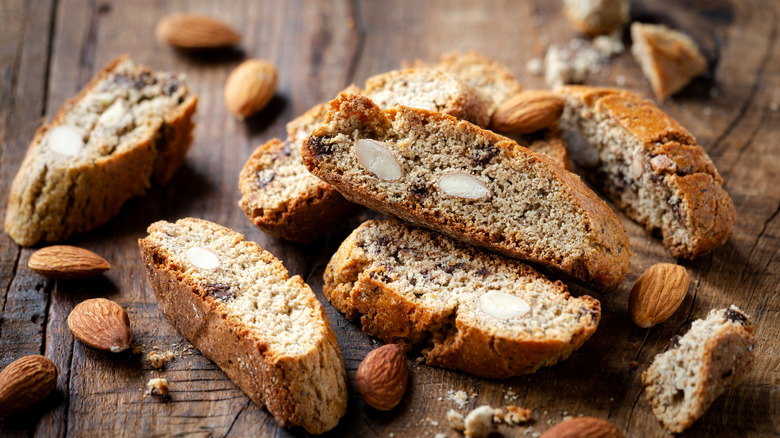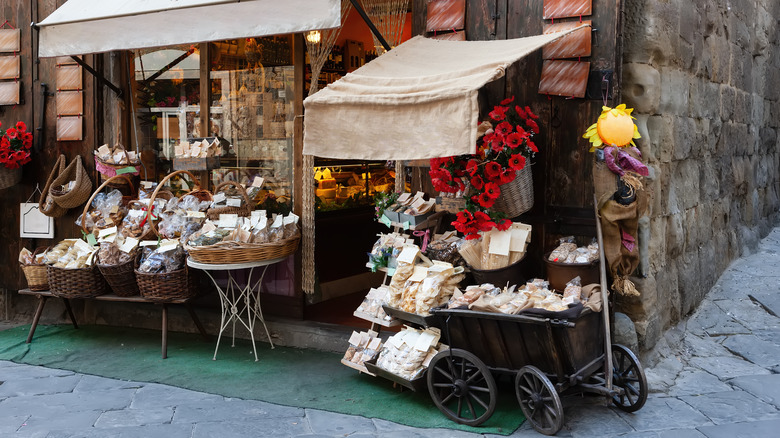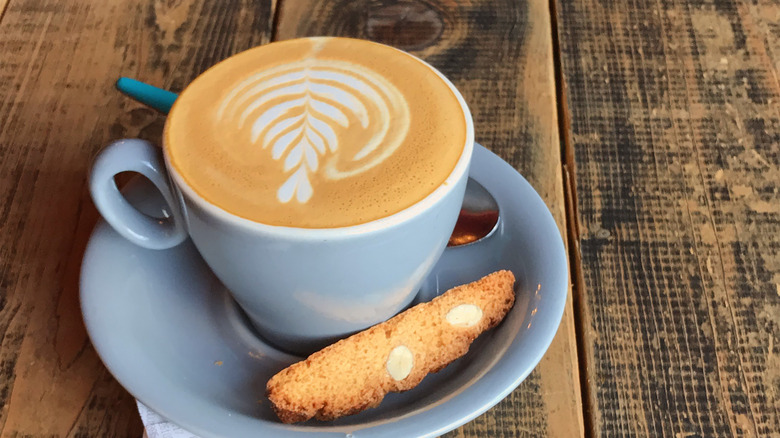The Commonplace Origins Of Biscotti
Today, biscotti comes in all sorts of flavors (like pistachio, vanilla, and even peppermint), with all sorts of goodies mixed in (like nuts, dried fruit, and lemon zest), and sometimes drizzled with all sorts of glazes (like dark chocolate, maple, and espresso). You might find them in a fancy-looking tin at your specialty food store or as a delightful surprise accompaniment to the cappuccino you ordered at that café down the street.
In Italy, the word biscotti is used the same way we use the word cookie: a general term for those indulgences we love, no matter their shape, texture, or sweetness. But here in America, we use the word biscotti to refer to a specific type of Italian cookie. You know the one — it's long and nutty, extra crunchy, and supremely dippable with a cup of coffee, a mug of hot chocolate, or even a glass of sweet wine. According to NPR, "The word biscotti is derived from the Latin biscoctus, meaning twice baked or cooked: The dough is formed into logs, baked, cooled and baked again." What we call biscotti, Tuscan Italians call cantucci.
Biscotti may be considered somewhat of a gourmet cookie today. Still, this twice-baked, not-too-sweet Italian treat has humble beginnings as a convenient, long-lasting food that dates back centuries.
Born in Rome, reimagined in Tuscany
While the biscotti we know today is most associated with 14th-century Tuscan origins, specialty food magazine The Nibble suggests that the birth of this crunchy cookie traces back to Rome, where it was created as a practical, travel-friendly form of sustenance for Roman legions. Because the biscotti were baked twice, taking on a new level of dryness, they lasted a long time before spoiling; it makes sense why they made the perfect snack to pack along for a seemingly endless voyage. So the cookies may have originated as more of a convenient ration than a tasty treat, but apparently, a Tuscan baker changed that.
According to The Nibble, when biscotti reappeared in Tuscany after the fall of the Roman Empire, a baker in Prato decided that the dry, crispy texture was ideal for soaking up sweet wine. It's here in Prato, a city abundant with almond groves, where local biscotti were flavored with almonds by local bakers; this is the classic flavor we associate with them today. Thanks to some bakers in Prato who reimagined them, these crumbly indulgences became extremely popular throughout Tuscany.
Biscotti then and now
NPR notes that as the cookies became more popular and began to spread throughout Italy's provinces, they took on different variations depending on the region. Maybe southern regions like Amalfi added in some lemon zest from the fruit for which they're known, or perhaps the Piedmont region, where hazelnuts grow aplenty, used hazelnuts in their dough instead of almonds. The signature cookie continued to work its way through Europe, and other countries soon created their versions of twice-baked tastiness. Per NPR, it wasn't until the 1990s that America started to appreciate biscotti as a go-to gourmet cookie when we began serving it at Italian restaurants and trendy coffee shops.
The best part about these Italian cookies is that they're easy to make, and the recipe options are endless. You can try them with the classic almond or anise, or get creative and throw in other favorite nibbles and flavors — from orange to cranberry and pecan to coffee. While the base of the cookie remains similar, it's fairly easy to adjust the add-ins and spruce them up however you'd like. Then all that's left to do is dunk them in your cup of morning joe or bite into them for a little something sweet after dinner.
Biscotti, cookies, cantucci — whatever you call them, whatever mix-ins you add to them, and whatever you pair them with, they are indeed a treat to be treasured.


